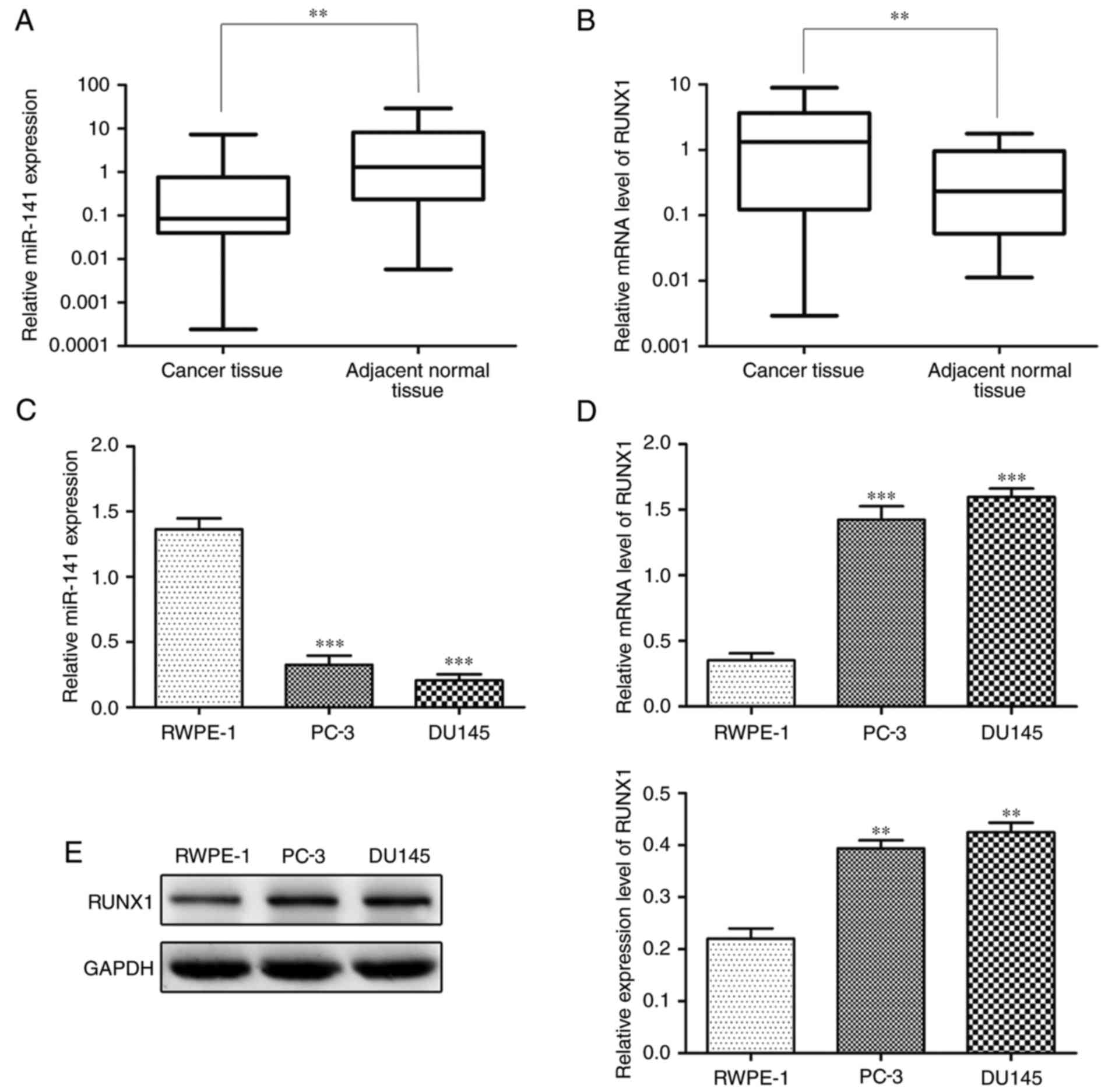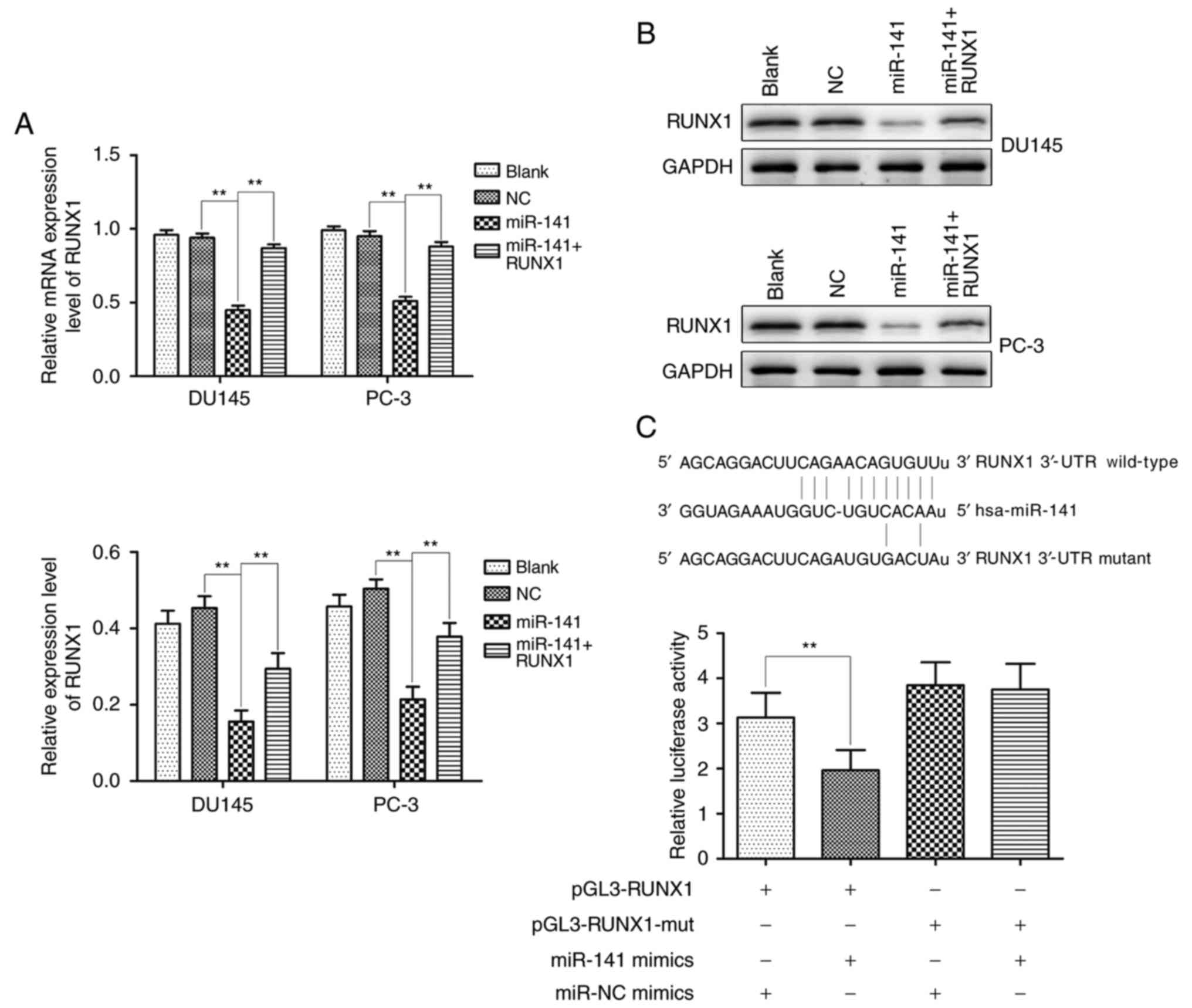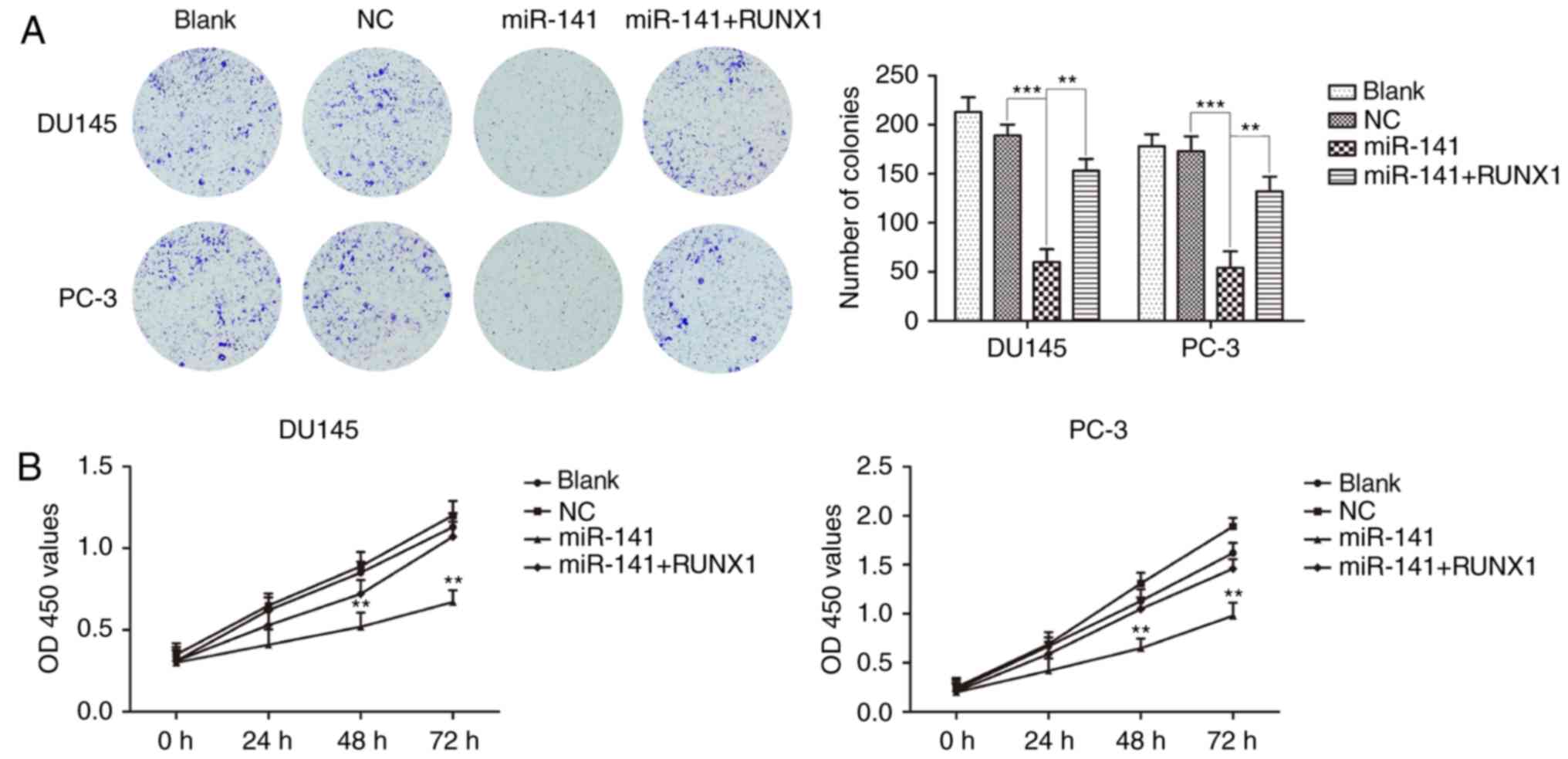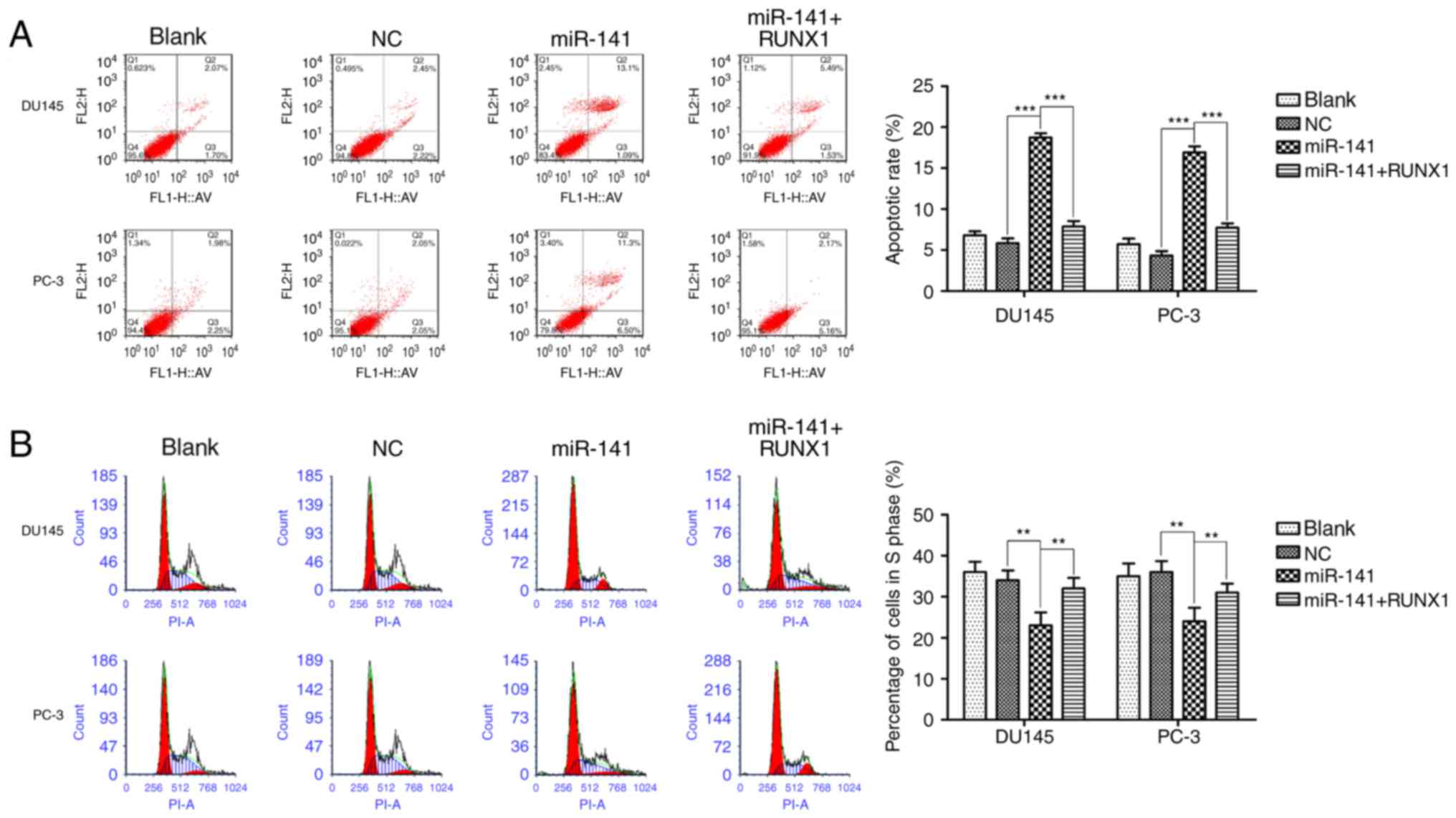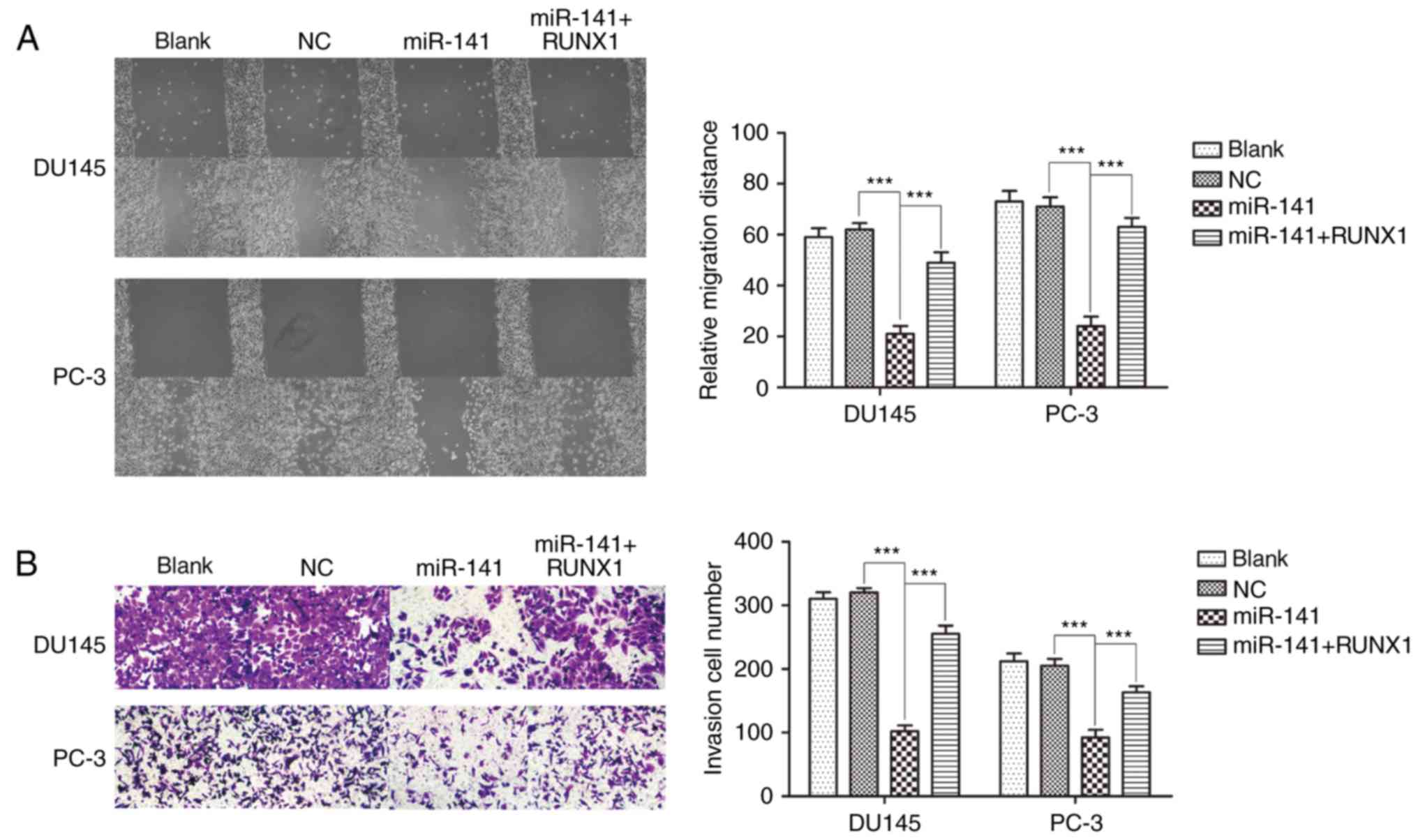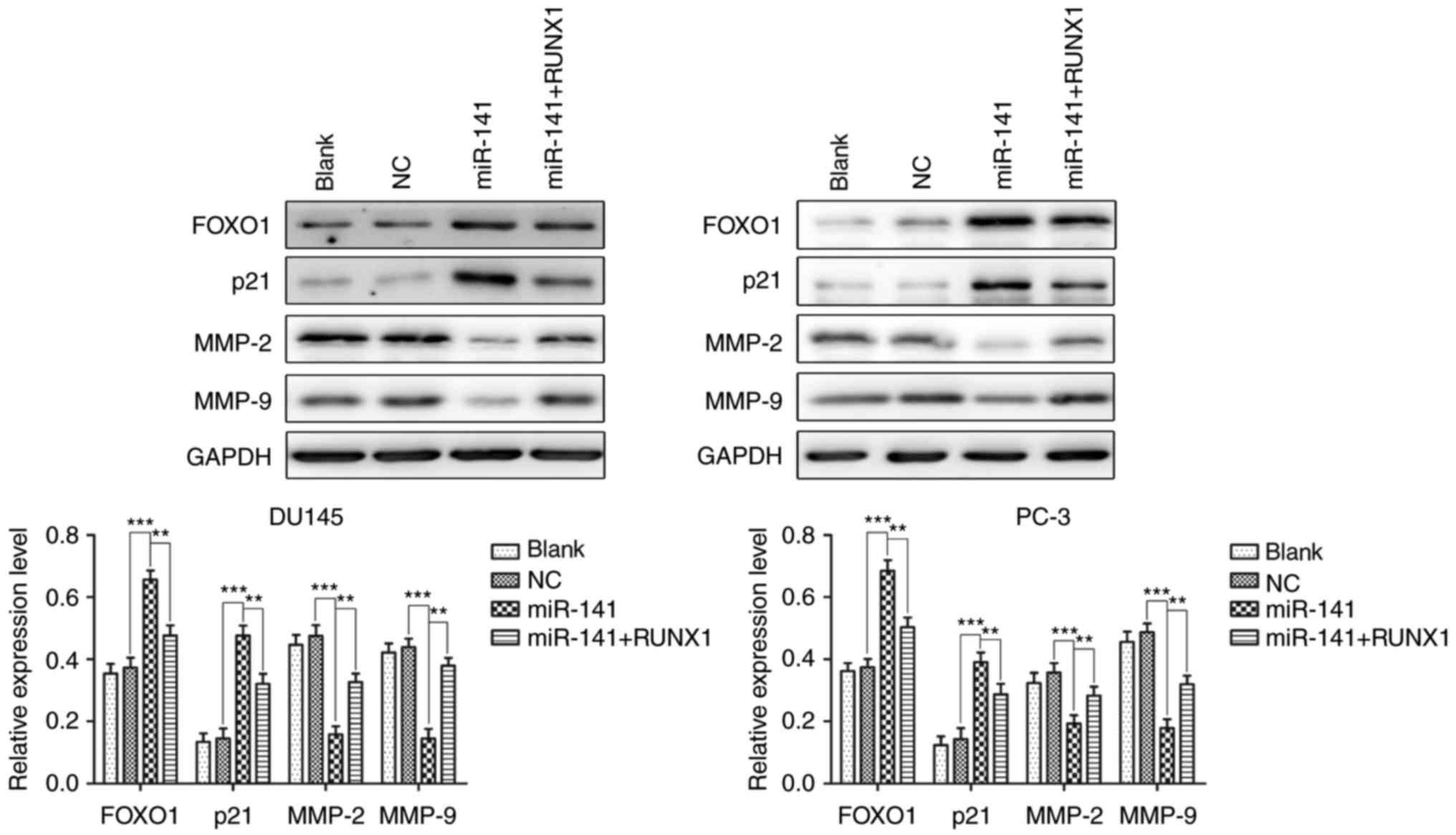miR-141 inhibits prostatic cancer cell proliferation and migration, and induces cell apoptosis via targeting of RUNX1
Retraction in: /10.3892/or.2023.8679
- Authors:
- Published online on: January 11, 2018 https://doi.org/10.3892/or.2018.6209
- Pages: 1454-1460
Abstract
Introduction
Prostate cancer (PCa) is the most common malignant tumor and the second leading cause of death in males all over the world. Although the diagnosis and treatment of PCa has greatly improved in recent years, the prognosis of PCa remains unsatisfactory due to the lack of knowledge of the molecular mechanisms of PCa development and progression. Therefore, there is a strong need for the development of new biomarkers and therapeutic targets that would be clinically useful in the treatment and diagnosis of PCa patients.
MicroRNAs (miRNAs) are single-stranded, short non-coding RNAs (~22–25 nt) that regulate mRNA expression at the post-transcriptional level by binding to the 3′-untranslated region (3′-UTR) region of the target mRNA. MiRNAs are frequently dysregulated in human cancer, and function as either oncogenes or tumor suppressors. Moreover, they have been demonstrated to play important roles in diverse biological and pathological processes, such as cellular proliferation, differentiation, metastasis, immune response, metabolism and apoptosis. Specifically, it has been suggested that miR-373 regulates cell proliferation, apoptosis, senescence, migration and invasion in several cancers (1). It has also been demonstrated that the expression level of miR-1 could be a novel predictive biomarker for PCa recurrence (2). In addition, one of the miR-200 family members, miR-141, may induce negative effects on the different clinical outcomes of prostate, ovarian, colon and breast cancers (3–5).
Runt-related transcription factor 1 (RUNX1) plays an important role in the maintenance of lineage differentiation, the generation of hemopoietic stem cells and the proliferation of stem cells (6–9). RUNX1 was originally considered to act as a tumor suppressor in myeloid leukemia. In recent years, a few studies have indicated that RUNX1 regulated diverse cancer cell growth, survival and differentiation (10–12). Nevertheless, the effects of miR-141 and RUNX1 on PCa development have not been investigated.
In the present study, we determined that miR-141 was downregulated in PCa tissues and PCa cells. We demonstrated that overexpression of miR-141 could suppress cell growth, migration and invasion and induce cell apoptosis via targeting of RUNX1 in PCa cells.
Materials and methods
Tissue samples
Prostate cancer (PCa) tissue samples were recruited from 55 patients who were pathologically diagnosed with PCa and underwent surgery at Jinling Hospital, School of Medicine, Nanjing University between June 2014 and June 2016. The adjacent normal tissues were representative of tissues that were located ~2–5 cm from tumors that were confirmed to contain no cancer cells. All tissue samples were immediately snap-frozen in liquid nitrogen and stored in a refrigerator at −80°C. Written informed consent was obtained from all patients, and the study was approved by the Institutional Ethics Committee of Nanjing Medical University. Additionally, all of the experiments were carried out under compliance with the government policies and the Helsinki Declaration.
Cell culture and transfection
The human PCa cell lines DU145 and PC-3 and the normal prostate epithelial cell line RWPE-1 were obtained from the American Type Culture Collection (ATCC; Manassas, VA, USA), and were maintained in RPMI-1640 medium (Gibco, Carlsbad, CA, USA) containing 10% fetal bovine serum (FBS) (Gibco-BRL, Invitrogen, Paisley, UK), 100 U/ml of penicillin and 100 µg/ml of streptomycin at 37°C and 5% CO2. miR-141 mimics, naked RUNX1 cDNA, and negative controls (GenePharma, Shanghai, China) were used in transfection experiments with Lipofectamine 2000 reagent (Invitrogen, Carlsbad, CA, USA) following the manufacturer's instructions.
RNA isolation and qRT-PCR
Total RNA was isolated from tissue samples and cell lines using TRIzol reagent (Life Technologies, Carlsbad, CA, USA) in line with the manufacturers' instructions. The miRNA or mRNA levels were detected using the 2−ΔΔCt method. The GAPDH mRNA level was used for normalization in the detection of the mRNA levels, and human U6 RNA was used as an internal control. The primers used were as follows: miR-141 forward, 5′-GTCCATCTTCCAGTACAGTGTTG-3′ and reverse, 5′-AGCCATCTTTACCAGACAGTGT-3′; RUNX1 forward, 5′-CCAGGUUGCAAGAUUUAAUTT-3′ and reverse, 5′-AUUAAAUCUUGCAACCUGGTT-3′; U6 forward, 5′-CTCGCTTCGGCAGCACA-3′ and reverse, 5′-AACGCTTCACGAATTTGCGT-3′; GAPDH forward, 5′-GTGGACCTGACCTGCGTCT-3′ and reverse, 5′-GGAGGAGTGGGTGTCGCTGT-3′. The thermo cycling conditions for RT-qPCR were: 95°C for 3 min, then 95°C for 30 sec, 53°C for 30 sec and 74°C for 2 min for 40 cycles and finally 74°C for 10 min. All samples were tested in triplicate.
Dual-luciferase reporter assay
The wild-type and mutated 3′-UTR sequences of RUNX1 mRNA containing the miR-141 targeting sequence (362H01; Invitrogen) were cloned into the pGL3 basic plasmid (GenScript, Nanjing, China), and were named respectively pGL3-RUNX1 and pGL3-RUNX1-mut, and the primer was forward, 5′-ACTACCCTGCAGCAGTTTGG-3′ and reverse, 5′-TTTTGAAGGCCAACTTGCCC-3′. Cells were cultured to 80% confluence in a 6-well plate, and transfected with 100 ng of pGL3-RUNX1, pGL3-RUNX1-mut, 50 nM of miR-141 mimics and the negative control, respectively. Firefly and Renilla luciferase activities were assessed consecutively using the Dual-Luciferase Assay (Promega, Madison, WI, USA) after 48 h of transfection according to the manufacturer's protocols. Transfection was repeated 3 times in triplicate.
Protein extraction and western blotting
The tissues and cells were lysed with RIPA buffer with protease inhibitors and PhoSTOP (Roche, Basel, Switzerland). The protein concentration was determined using a BCA Protein Assay kit (Pierce Biotechnology, Rockford, IL, USA). Protein (10 µg) was loaded per lane, and separated by 10% SDS-polyacrylamide electrophoresis. Then, protein was transferred onto polyvinylidene fluoride (PVDF) membranes (Millipore, Billerica, MA, USA), blocked, incubated with primary antibodies at 4°C overnight, and further incubated with secondary antibodies. The blots were visualized with an ECL reagent (Millipore). ImageJ software was used to quantify western blotting data. The primary antibodies used were anti-RUNX1 (dilution 1:1,000; rabbit polyclonal; cat. no. 4334), anti-FOXO1 (dilution 1:1,000; rabbit polyclonal; cat. no. 9454), anti-p21 (dilution 1:1,000; mouse monoclonal; cat. no. 2946), anti-MMP-2 (dilution 1:1,000; rabbit monoclonal; cat no. 87809), anti-MMP-9 (dilution 1:1,000; rabbit monoclonal; cat. no. 15561) [all from Cell Signaling Technology (CST) Danvers, MA, USA] and anti-GAPDH (dilution 1:1,000; mouse monoclonal; cat. no. 60004-1-Ig; ProteinTech, Wuhan, China). The secondary antibodies used were goat anti-rabbit IgG H&L (HRP) (dilution 1:5,000; cat. no. ab6721), goat anti-mouse IgG H&L (HRP) (dilution 1:5,000; cat. no. ab6789; both from Abcam, Cambridge, MA, USA).
Cell proliferation and colony formation assays
A colony formation assay was also used to detect cell proliferation. Cells (50–150/well) were seeded in a 6-well plate. The cells were allowed to incubate at 37°C for 14 days, and then the cells were stained with Giemsa solution after 3 washes with PBS. The total number of colonies was calculated from 7 random fields. All experiments were performed in triplicate.
Cell proliferation was detected with a Cell Counting Kit-8 (CCK-8) assay (Beyotime, Nantong, China) after 24, 48 and 72 h of transfection according to the manufacturer's protocol. The absorbance was assessed using the Tecan Infinite M200 Multi-Mode Microplate Reader (Tecan Benelux BVBA, Mechelen, Belgium) at 450 nm.
Cell cycle and apoptosis analysis
For the cell cycle assay, at 48 h post-transfection, the cells were collected and assessed using a BD Biosciences FACSCalibur flow cytometer (BD Biosciences, Franklin Lakes, NJ, USA). For the cell apoptosis analysis, the cells were harvested and stained with an Annexin V-FITC/propidium iodide kit (Beyotime Institute of Biotechnology, Shanghai, China) according to the manufacturer's instructions. Data were analyzed by flow cytometry (BD Biosciences). All experiments were performed in triplicate independently.
Migration and invasion assays
Cell migration was assessed by wound healing assay. Cells (5×106/well) were grown in 6-well plates. When cells had reached 90% confluency, cell layers were scratched with sterile plastic tips in a representative region, washed with PBS twice, cells were transfected, media was changed after 6 h, and migration of the cells into the scratch was observed after 24 h.
Cell invasion was determined by Transwell assay. Cells were transfected and cultured for 24 h, then were added to the upper surface of each insert coated with Matrigel (diluted 1:8; BD Biosciences). Cells were incubated for 24 h at 5% CO2 at 37%, non-invading cells were removed with cotton buds from the top chambers, and invading cells were fixed, stained and counted. Three replicates were obtained.
Statistical analysis
Experimental data were analyzed using the GraphPad Prism 5.0 software (GraphPad Software, Inc., La Jolla, CA, USA). The Chi-square (χ2) test was applied in comparisons of enumeration data among groups. Measurement data were expressed as the mean ± standard deviation (SD). Differences in measurement data between groups were analyzed using the t-test or the rank sum test.
Results
Downregulation of miR-141 and upregulation of RUNX1 in PCa tissues and PCa cell lines
We detected the expression level of miR-141 and RUNX1, respectively, in PCa and adjacent normal tissues by qRT-PCR. The expression level of miR-141 was significantly lower and RUNX1 was significantly higher in PCa tissues in comparison to adjacent normal tissues (Fig. 1A and B). In addition, significantly lower miR-141 expression and higher RUNX1 expression were observed in PCa cell lines (PC-3 and DU145) than in the normal prostate epithelial cell line (RWPE-1) (Fig. 1C-E).
miR-141 targets RUNX1
Transcription factor RUNX1 is modulated by a number of miRNAs. Over 60 conserved miRNAs targeting the longest RUNX1 3′-UTR were predicted by bioinformatics tools (miRBase, PicTar and TargetScan), and miR-141 was one of the predicted targets. As revealed by qRT-PCR and western blotting, the miR-141 group significantly downregulated RUNX1 expression in comparison with the normal control group, however, the expression of RUNX1 in the miR-141 + RUNX1 group was higher than that in the miR-141 group (Fig. 2A and B). Furthermore, the dual-luciferase reporter system assay revealed that miR-141 significantly suppressed luciferase activity compared to the control group, whereas the suppressive effect was abrogated when the putative binding site was mutated (Fig. 2C). These results demonstrated that RUNX1 was the direct target of miR-141.
miR-141 upregulation inhibits PCa cell proliferation and cell cycle progression and induces apoptosis
Colony formation and CCK-8 assays revealed that the miR-141 mimic group significantly inhibited PCa cell proliferation compared with the normal control group, and the inhibitory effects on the proliferation of PCa cells were attenuated after the addition of RUNX1 (Fig. 3A and B). Then, we respectively detected the effect of miR-141 upregulation on apoptosis and cell cycle progression. The upregulation of miR-141 induced cell apoptosis (Fig. 4A), and increased the G0/G1 population, decreasing the S phase cell fractions (Fig. 4B) in DU145 and PC-3 cell lines, and addition of RUNX1 attenuated these effects.
miR-141 upregulation suppresses PCa cell migration and invasion. A cell scratch assay indicated that miR-141 upregulation suppressed cell migration compared with the normal control group in DU145 and PC-3 cell lines, and addition of RUNX1 reversed the inhibitory effects of miR-141 on cell migration, while the normal control group was not significantly different from the blank control group (Fig. 5A). A Transwell assay revealed that the effect on cell invasion was analogous with cell migration when miR-141 was overexpressed (Fig. 5B).
miR-141 upregulation increases the expression of FOXO1 and decreases the expression of MMP-2 and MMP-9 via decreased RUNX1 expression
FOXO1 and p21 are both significant proteins involved in the regulation of the cell cycle and apoptosis in various cells (13–15). MMP-2 and MMP-9 are gelatinases of the matrix metalloproteinase family, which play an important role in cancer cell invasion and migration (16–18). Hence, we detected the protein expression of FOXO1, p21, MMP-2 and MMP-9 in each group of cells using western blotting to further examine the mechanism of miR-141 upregulation in PCa cell growth and apoptosis. The results revealed that miR-141 upregulation in the DU145 and PC-3 cell lines increased the expression of FOXO1 and p21 and decreased the expression of MMP-2 and MMP-9, and the effects were reversed after the addition of RUNX1 (Fig. 6). Collectively, miR-141 upregulation may occur via means of RUNX1 downregulation to increase FOXO1 and p21 protein expression and decrease MMP-2 and MMP-9 protein expression.
Discussion
Prostate cancer (PCa) has become one of the leading causes of cancer-related deaths second only to lung cancer. It is extremely important to find effective diagnosis and treatment methods in PCa. Accumulating evidence has indicated that microRNAs may regulate various cancer processes and be a new source as specific biomarkers for malignancy. Numerous studies have notably increased their focus on microRNA expression profiles in PCa (19–24).
Notably, miR-141 may play an important role in tumor growth and metastasis by targeting the regulation of the expression of ANP32E (25). Additionally, reduced expression of miR-200c/141 was associated with increased expression of ZEB1 and/or ZEB2 to promote cell migration and invasion in various cancers (26–28). Ectopic expression of miR-141 could serve to inhibit apoptosis in cancer cells through the regulation of the expression of PTEN (29–31). Similarly, our study determined that the expression level of miR-141 was significantly lower in PCa tissues than that in adjacent normal tissues. We also discovered that the expression of miR-141 in DU145 and PC-3 cell lines was significantly decreased compared with human normal prostate epithelial cells. However, overexpressed miR-141 suppressed the proliferation and migration of PCa cells, and induced cell apoptosis. These findings revealed that miR-141 potentially played a restraining role in PCa development.
As a DNA-binding transcription factor, RUNX1 promoted and enhanced the expression of target genes by acting as an organizing factor (32). It was reported that the inhibition of miR-378 in MCF7 cells increased RUNX1 levels and cell migration (33). In addition, miR-215 promoted the growth and metastasis of GC cells by targeting RUNX1, and RUNX1 can partially reverse the effects of miR-215 (34). In the present study, we found that RUNX1 was significantly overexpressed in PCa tissues compared with adjacent normal tissues. In addition, when miR-141 was upregulated in DU145 and PC-3 cells, the protein and mRNA expression of RUNX1 were both decreased. We further demonstrated that RUNX1 is a target gene of miR-141 using luciferase reporter and RNA immunoprecipitation (RIP) assays. Moreover, RUNX1 upregulation could antagonize the effects of miR-141 on PCa cells. The absence of the RUNX1 group alone is a flaw in our study.
FOXO1 is a transcription factor involved in apoptosis, oxidative stress, and cell differentiation (35,36). It has been demonstrated that FOXO1 promotes the expression of numerous cell cycle proteins, such as p21waf/cip and p15ink (37,38). MMP-2 and MMP-9 are key members of the MMP family that degrade and remodel the extracellular matrix (EMC), and play an important role in tumor growth and metastasis. In the present study, we confirmed that miR-141 upregulation increased the expression of FOXO1 and p21, and decreased the expression of MMP-2 and MMP-9 in PCa cells. Moreover, the addition of RUNX1 could reverse these effects. Therefore, we deduced that miR-141 upregulation increased the expression of FOXO1 and p21 and decreased the expression of MMP-2 and MMP-9 levels through RUNX1 downregulation.
In conclusion, our findings revealed that miR-141 could inhibit cell proliferation, migration and induce apoptosis in PCa cells by downregulating RUNX1, indicating that miR-141 may be a novel diagnostic and prognostic marker for patients with advanced PCa.
Acknowledgements
This study was supported by Project funded by China Postdoctoral Science Foundation (No. 2017T100825, No. 2016M602981) and China Jiangsu Planned Projects for Postdoctoral Research Funds (No. 1601160B).
Competing interests
The authors declare that they have no competing interests.
References
|
Wei F, Cao C, Xu X and Wang J: Diverse functions of miR-373 in cancer. J Transl Med. 13:1622015. View Article : Google Scholar : PubMed/NCBI | |
|
Wei W, Leng J, Shao H and Wang W: MiR-1, a potential predictive biomarker for recurrence in prostate cancer after radical prostatectomy. Am J Med Sci. 353:315–319. 2017. View Article : Google Scholar : PubMed/NCBI | |
|
Mitchell PS, Parkin RK, Kroh EM, Fritz BR, Wyman SK, Pogosova-Agadjanyan EL, Peterson A, Noteboom J, O'Briant KC, Allen A, et al: Circulating microRNAs as stable blood-based markers for cancer detection. Proc Natl Acad Sci USA. 105:pp. 10513–10518. 2008; View Article : Google Scholar : PubMed/NCBI | |
|
Cheng H, Zhang L, Cogdell DE, Zheng H, Schetter AJ, Nykter M, Harris CC, Chen K, Hamilton SR and Zhang W: Circulating plasma MiR-141 Is a novel biomarker for metastatic colon cancer and predicts poor prognosis. PLoS One. 6:e177452011. View Article : Google Scholar : PubMed/NCBI | |
|
Madhavan D, Zucknick M, Wallwiener M, Cuk K, Modugno C, Scharpff M, Schott S, Heil J, Turchinovich A, Yang R, et al: Circulating miRNAs as surrogate markers for circulating tumor cells and prognostic markers in metastatic breast cancer. Clin Cancer Res. 18:5972–5982. 2012. View Article : Google Scholar : PubMed/NCBI | |
|
Link KA, Chou FS and Mulloy JC: Core binding factor at the crossroads: Determining the fate of the HSC. J Cell Physiol. 222:50–56. 2010. View Article : Google Scholar : PubMed/NCBI | |
|
Lam K and Zhang DE: RUNX1 and RUNX1-ETO: Roles in hematopoiesis and leukemogenesis. Front Biosci. 17:1120–1139. 2012. View Article : Google Scholar | |
|
Friedman AD: Cell cycle and developmental control of hematopoiesis by Runx1. J Cell Physiol. 219:520–524. 2009. View Article : Google Scholar : PubMed/NCBI | |
|
Swiers G, de Bruijn M and Speck NA: Hematopoietic stem cell emergence in the conceptus and the role of Runx1. Int J Dev Biol. 54:1151–1163. 2010. View Article : Google Scholar : PubMed/NCBI | |
|
Lund AH and van Lohuizen M: RUNX: A trilogy of cancer genes. Cancer Cell. 1:213–215. 2002. View Article : Google Scholar : PubMed/NCBI | |
|
Ito Y, Bae SC and Chuang LS: The RUNX family: Developmental regulators in cancer. Nat Rev Cancer. 15:81–95. 2015. View Article : Google Scholar : PubMed/NCBI | |
|
Wotton SF, Blyth K, Kilbey A, Jenkins A, Terry A, Bernardin-Fried F, Friedman AD, Baxter EW, Neil JC and Cameron ER: RUNX1 transformation of primary embryonic fibroblasts is revealed in the absence of p53. Oncogene. 23:5476–5486. 2004. View Article : Google Scholar : PubMed/NCBI | |
|
Zhang Y, Gan B, Liu D and Paik J: FoxO family members in cancer. Cancer Biol Ther. 12:253–259. 2011. View Article : Google Scholar : PubMed/NCBI | |
|
Coomans de Brachène A and Demoulin JB: FOXO transcription factors in cancer development and therapy. Cell Mol Life Sci. 73:1159–1172. 2016. View Article : Google Scholar : PubMed/NCBI | |
|
Georgakilas AG, Martin OA and Bonner WM: p21: A two-faced genome guardian. Trends Mol Med. 23:310–319. 2017. View Article : Google Scholar : PubMed/NCBI | |
|
Klein T and Bischoff R: Physiology and pathophysiology of matrix metalloproteases. Amino Acids. 41:271–290. 2011. View Article : Google Scholar : PubMed/NCBI | |
|
Overall CM: Molecular determinants of metalloproteinase substrate specificity: Matrix metalloproteinase substrate binding domains, modules, and exosites. Mol Biotechnol. 22:51–86. 2002. View Article : Google Scholar : PubMed/NCBI | |
|
Foda HD and Zucker S: Matrix metalloproteinases in cancer invasion, metastasis and angiogenesis. Drug Discovery Today. 6:478–482. 2001. View Article : Google Scholar : PubMed/NCBI | |
|
Martens-Uzunova ES, Jalava SE, Dits NF, van Leenders GJ, Møller S, Trapman J, Bangma CH, Litman T, Visakorpi T and Jenster G: Diagnostic and prognostic signatures from the small non-coding RNA transcriptome in prostate cancer. Oncogene. 31:978–991. 2012. View Article : Google Scholar : PubMed/NCBI | |
|
Hulf T, Sibbritt T, Wiklund ED, Patterson K, Song JZ, Stirzaker C, Qu W, Nair S, Horvath LG, Armstrong NJ, et al: Epigenetic-induced repression of microRNA-205 is associated with MED1 activation and a poorer prognosis in localized prostate cancer. Oncogene. 32:2891–2899. 2013. View Article : Google Scholar : PubMed/NCBI | |
|
Santillan M, Devor EJ, Leslie KK, Hunter SK and Santillan DA: A microRNA expression profile of normal placental development. Scientific Meeting. 20:pp. 257A2013; | |
|
Karatas OF, Guzel E, Suer I, Ekici ID, Caskurlu T, Creighton CJ, Ittmann M and Ozen M: miR-1 and miR-133b are differentially expressed in patients with recurrent prostate cancer. PLoS One. 9:e986752014. View Article : Google Scholar : PubMed/NCBI | |
|
Selth LA, Townley SL, Bert AG, Stricker PD, Sutherland PD, Horvath LG, Goodall GJ, Butler LM and Tilley WD: Circulating microRNAs predict biochemical recurrence in prostate cancer patients. Br J Cancer. 109:6412013. View Article : Google Scholar : PubMed/NCBI | |
|
Nguyen HC, Xie W, Yang M, Hsieh CL, Drouin S, Lee GS and Kantoff PW: Expression differences of circulating microRNAs in metastatic castration resistant prostate cancer and low-risk, localized prostate cancer. Prostate. 73:346–354. 2013. View Article : Google Scholar : PubMed/NCBI | |
|
Li P, Xu T, Zhou X, Liao L, Pang G, Luo W, Han L, Zhang J, Luo X, Xie X and Zhu K: Downregulation of miRNA-141 in breast cancer cells is associated with cell migration and invasion: Involvement of ANP32E targeting. Cancer Med. 6:662–672. 2017. View Article : Google Scholar : PubMed/NCBI | |
|
Nishijima N, Seike M, Soeno C, Chiba M, Miyanaga A, Noro R, Sugano T, Matsumoto M, Kubota K and Gemma A: miR-200/ZEB axis regulates sensitivity to nintedanib in non-small cell lung cancer cells. Int J Oncol. 48:937–944. 2016. View Article : Google Scholar : PubMed/NCBI | |
|
Lahat G, Lubezky N, Loewenstein S, Nizri E, Gan S, Pasmanik-Chor M, Hayman L, Barazowsky E, Ben-Haim M and Klausner JM: Epithelial-to-mesenchymal transition (EMT) in intraductal papillary mucinous neoplasm (IPMN) is associated with high tumor grade and adverse outcomes. Ann Surg Oncol. 21 Suppl 4:S750–S757. 2014. View Article : Google Scholar : PubMed/NCBI | |
|
Tamagawa S, Beder LB, Hotomi M, Gunduz M, Yata K, Grenman R and Yamanaka N: Role of miR-200c/miR-141 in the regulation of epithelial-mesenchymal transition and migration in head and neck squamous cell carcinoma. Int J Mol Med. 33:879–886. 2014. View Article : Google Scholar : PubMed/NCBI | |
|
Liu Y, Zhao R, Wang H, Luo Y, Wang X, Niu W, Zhou Y, Wen Q, Fan S, Li X, et al: miR-141 is involved in BRD7-mediated cell proliferation and tumor formation through suppression of the PTEN/AKT pathway in nasopharyngeal carcinoma. Cell Death Dis. 7:e21562016. View Article : Google Scholar : PubMed/NCBI | |
|
Ji J, Qin Y, Ren J, Lu C, Wang R, Dai X, Zhou R, Huang Z, Xu M, Chen M, et al: Mitochondria-related miR-141-3p contributes to mitochondrial dysfunction in HFD-induced obesity by inhibiting PTEN. Sci Rep. 5:162622015. View Article : Google Scholar : PubMed/NCBI | |
|
Jin YY, Chen QJ, Xu K, Ren HT, Bao X, Ma YN, Wei Y and Ma HB: Involvement of microRNA-141-3p in 5-fluorouracil and oxaliplatin chemo-resistance in esophageal cancer cells via regulation of PTEN. Mol Cell Biochem. 422:161–170. 2016. View Article : Google Scholar : PubMed/NCBI | |
|
Mao S, Frank RC, Zhang J, Miyazaki Y and Nimer SD: Functional and physical interactions between AML1 proteins and an ETS protein, MEF: Implications for the pathogenesis of t(8;21)-positive leukemias. Mol Cell Biol. 19:3635–3644. 1999. View Article : Google Scholar : PubMed/NCBI | |
|
Browne G, Dragon JA, Hong D, Messier TL, Gordon JA, Farina NH, Boyd JR, VanOudenhove JJ, Perez AW, Zaidi SK, et al: MicroRNA-378-mediated suppression of Runx1 alleviates the aggressive phenotype of triple-negative MDA-MB-231 human breast cancer cells. Tumour Biol. 37:88252016. View Article : Google Scholar : PubMed/NCBI | |
|
Li N, Zhang QY, Zou JL, Li ZW, Tian TT, Dong B, Liu XJ, Ge S, Zhu Y, Gao J and Shen L: miR-215 promotes malignant progression of gastric cancer by targeting RUNX1. Oncotarget. 7:4817–4828. 2016.PubMed/NCBI | |
|
Chiribau CB, Cheng L, Cucoranu IC, Yu YS, Clempus RE and Sorescu D: FOXO3A regulates peroxiredoxin III expression in human cardiac fibroblasts. J Biol Chem. 283:8211–8217. 2008. View Article : Google Scholar : PubMed/NCBI | |
|
Ronnebaum SM and Patterson C: The FoxO family in cardiac function and dysfunction. Annu Rev Physiol. 72:81–94. 2010. View Article : Google Scholar : PubMed/NCBI | |
|
Gomis RR, Alarcón C, He W, Wang Q, Seoane J, Lash A and Massagué J: A FoxO-Smad synexpression group in human keratinocytes. Proc Natl Acad Sci USA. 103:pp. 12747–12752. 2006; View Article : Google Scholar : PubMed/NCBI | |
|
Seoane J, Le HV, Shen L, Anderson SA and Massagué J: Integration of Smad and Forkhead pathways in the control of neuroepithelial and glioblastoma cell proliferation. Cell. 117:211–223. 2004. View Article : Google Scholar : PubMed/NCBI |



